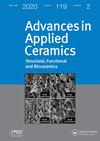Kinetics investigation of alumina ceramics corrosion in nitric acid
IF 1.6
4区 材料科学
Q3 MATERIALS SCIENCE, CERAMICS
引用次数: 0
Abstract
ABSTRACT The most widely used ceramic material is aluminium oxide, known as alumina. Due to its superior properties such as chemical stability, high wear resistance, refractoriness and so on, it is ideal for applications in aggressive environment. This type of environment often includes exposure to corrosive solids, liquids and gases. When ceramics come in contact with corrosive medium, several corrosion mechanisms can occur, depending on a number of parameters. Therefore, the corrosion behaviour of cold isostatically pressed (CIP) high purity alumina ceramics was observed under different conditions: 0.5, 1.25 and 2 mol dm−3 of nitric acid at 25°C, 40°C and 55°C through 10 days. Purity of used alumina ceramics was 99.8345 wt. % with 0.1655 wt. % of both sintering aid (MgO) and impurities (SiO2, CaO, Na2O and Fe2O3). The results show that Al2O3 ceramics exhibit good corrosion resistance in nitric acid. Al2O3 corrosion behaviour varies depending on the temperature, time and HNO3 concentration. In view of the reaction kinetics, it proceeds in the near-parabolic law in HNO3 aqueous solution and decreases with an increase of the HNO3 concentration.氧化铝陶瓷在硝酸中的腐蚀动力学研究
应用最广泛的陶瓷材料是氧化铝,即氧化铝。由于其优异的性能,如化学稳定性,高耐磨性,耐火性等,是在腐蚀性环境中的理想应用。这种类型的环境通常包括暴露于腐蚀性固体,液体和气体。当陶瓷与腐蚀性介质接触时,根据一些参数,可以发生几种腐蚀机制。因此,在不同条件下观察了冷等静压(CIP)高纯氧化铝陶瓷的腐蚀行为:0.5,1.25和2 mol dm−3的硝酸在25°C, 40°C和55°C下持续10天。所用氧化铝陶瓷的纯度为99.8345 wt. %,助烧剂(MgO)和杂质(SiO2、CaO、Na2O和Fe2O3)的纯度均为0.1655 wt. %。结果表明,Al2O3陶瓷在硝酸中具有良好的耐腐蚀性。Al2O3的腐蚀行为随温度、时间和HNO3浓度的变化而变化。从反应动力学上看,该反应在HNO3水溶液中呈近抛物线规律进行,随HNO3浓度的增加而减小。
本文章由计算机程序翻译,如有差异,请以英文原文为准。
求助全文
约1分钟内获得全文
求助全文
来源期刊

Advances in Applied Ceramics
工程技术-材料科学:硅酸盐
CiteScore
4.40
自引率
4.50%
发文量
17
审稿时长
5.2 months
期刊介绍:
Advances in Applied Ceramics: Structural, Functional and Bioceramics provides international coverage of high-quality research on functional ceramics, engineering ceramics and bioceramics.
 求助内容:
求助内容: 应助结果提醒方式:
应助结果提醒方式:


